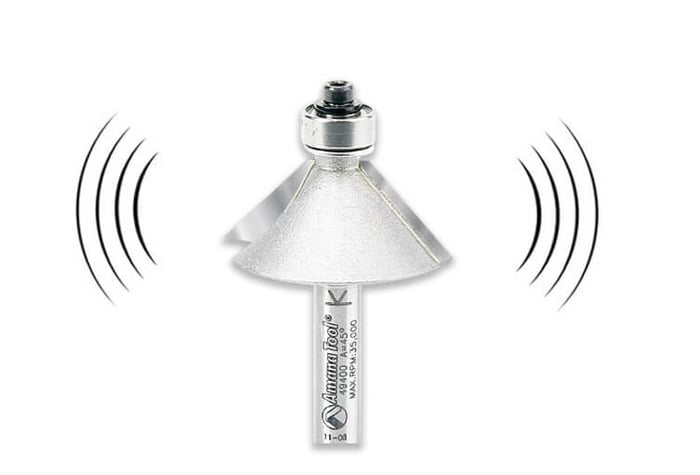
10 Common Router Bit Mistakes to Avoid
Are you ready to take your woodworking skills to the next level? Then pay attention, because this article is for you. In the world of woodworking, using a router is a fundamental skill. However, it's easy to make router bit mistakes that can affect the quality of your work. Don't worry, we've got you covered.
The Importance of Proper Router Bit Usage
Proper router bit usage is crucial for achieving precise cuts and ensuring safety. Always select the right router bit for the specific task at hand, considering factors like bit shape, material, and size.
Using dull or damaged router bits can lead to poor results and safety hazards, so regular inspection and maintenance are essential.
Additionally, maintaining the appropriate speed and feed rate during routing operations is vital for optimal performance and longevity of router bits.
Remember, utilizing the correct router bit and following proper usage guidelines can significantly enhance the quality of woodworking projects while minimizing the risk of accidents.
Common Router Bit Mistakes & Their Potential Impact on Your Woodworking Projects
Utilizing router bits incorrectly can lead to flawed woodworking projects. Some common mistakes and their potential impacts include:
- Wrong speed: Using a high speed with a large bit can cause burning, while a low speed may result in tear-out.
- Incorrect feed direction: This can lead to grain tear-out, affecting the project's finish.
- Improper bit height: Setting the bit too low can cause burning, while setting it too high can create an unsafe situation.
Here are the top 10 router bit mistakes and how to avoid them, in no particular order:
Mistake #1: Choosing the Wrong Bit for the Material
- Identify the material you are working with, such as wood, metal, or plastic.
- Choose the appropriate router bit based on the material, such as a straight bit for wood or a spiral upcut bit for plastic. (We categorize router bits by material as well as profile, to help with this decision.)
- Consider the density and hardness of the material when selecting the bit.
- Ensure the bit is suitable for the specific cut you intend to make, whether it's a dado, rabbet, or edge profile.
- Always follow the manufacturer's recommendations for bit speed and feed rate for the chosen material.
Mistake #2: Ignoring Bit Sharpness
Ignoring bit sharpness can result in rough cuts, tear-out, and increased strain on the router. Make sure to check and sharpen or replace bits as needed before use. A dull bit can lead to subpar cuts and potential damage to the wood.
Pro-tip: Keep your bits clean and sharp, & consider investing in a diamond sharpening stone for precise honing. Read more about Router Bit Maintenance.
Mistake #3: Incorrect Router Bit Speed Settings
- Refer to the router bit manufacturer's guidelines for recommended speed settings based on the size and material of the router bit.
- Adjust the speed settings according to the type and hardness of the wood to prevent burning or tear-out.
- Use lower speeds for larger router bits to avoid vibrations and ensure safety.
- Maintain and clean the router and bits regularly to extend their lifespan and maintain optimal performance.
For more on this, see Understanding CNC Feeds and Speeds. (Not only for CNC!)
Mistake #4: Improper Bit Installation and Depth Setting
- Improper Bit Installation: Always make sure to unplug the router before changing bits. Use the appropriate size wrenches to secure the bit in place.
- Depth Setting: Always double-check the depth setting before operation. Test on a scrap piece to confirm the accuracy of the setting.
Mistake #5: Overlooking the Need for Regular Bit Maintenance
- Clean the router bit after each use to remove wood pitch and resin buildup.
- Inspect the bit for damage such as dullness, chipping, or cracks before every use.
- Sharpen dull bits using a diamond file or replace them to ensure clean cuts.
Mistake #6: Forcing the Bit Through the Material
- Choose the appropriate router bit for the material, such as a straight bit for cutting straight into the wood.
- Set the correct router speed and feed rate based on the material to avoid overpowering the bit.
- Allow the bit to do the work by moving it at a steady pace without forcing it through the material.
Fact: Using excessive force with the router bit can lead to overheating, chipping of the material, and a shorter lifespan for the bit.
Mistake #7: Neglecting Safety Precautions
- Wear protective gear: It is important to always use safety glasses, ear protection, and a dust mask to protect yourself from wood chips, loud noise, and fine dust.
- Secure workpiece: Use clamps or a vise to secure the workpiece in place to prevent it from moving unpredictably and causing injury.
- Follow instructions: Make sure to read and follow the manufacturer's guidelines and recommendations for the specific router bit being used.
Mistake #8: Using Damaged or Worn Bits
- Regularly inspect bits for wear and tear, such as dull edges or chipped surfaces.
- Replace damaged bits promptly to avoid compromising the quality of cuts or damaging the workpiece.
- Invest in high-quality bits to minimize wear and extend their lifespan.
Using damaged router bits not only affects the precision of cuts but also poses safety hazards in the workshop.
Mistake #9: Failing to Secure the Workpiece Properly
- Use clamps or a vise to securely hold the workpiece in place.
- Take into account the direction of the bit rotation to avoid the workpiece from being pulled away.
- Make sure that the work area is free of debris that could affect the stability of the workpiece.
- Before beginning the routing process, double-check the stability of the workpiece.
- Be sure to wear proper safety equipment, such as goggles and gloves, when securing the workpiece.
Mistake #10: Overlooking Climbing Cuts
- Use the correct router bit for the particular task to avoid making climbing cuts.
- Feed the material against the rotation of the bit to prevent climbing cuts. See illustration, below.
- Secure the workpiece with clamps or a router table to maintain control and prevent climbing cuts.
To avoid climbing cuts, always prioritize safety by wearing suitable protective gear and using sharp, high-quality router bits.
 |
Always feed against the rotation of the bit.This can sometimes be confusing and the direction depends on whether you’re hand-held routing the perimeter of a workpiece, the interior of a workpiece, or using the router in a table. When hand-held routing the outer perimeter of a workpiece, such as the edge of a tabletop, push the router in a counter-clockwise direction. When hand-held routing the interior of a workpiece, such as an opening or cutout, push the router in a clockwise direction. When using a table mounted router, always push the stock from right to left. |
Best Practices for Effective & Safe Router Use
- Wear protective gear: Always remember to wear safety glasses and hearing protection when using a router. (Also, see our Free Downloadable Safety Posters to print & hang reminders in your shop.)
- Secure your workpiece: Make sure to use clamps or a vise to secure the material you are working on.
- Use sharp bits: It is important to use sharp bits to avoid burning and kickback, so be sure to regularly sharpen or replace them.
- Feed direction: When cutting, move the router against the rotation of the bit for a smooth and clean cut.
Frequently Asked Questions
What are common router bit mistakes to avoid?
There are several common router bit mistakes that can be easily avoided, such as using the wrong size bit, not properly securing the material, and not adjusting the speed correctly.
How do I prevent using the wrong size router bit?
To avoid using the wrong size router bit, always double check the size before use and make sure it matches the size of the desired cut. It is also helpful to have a variety of router bits in different sizes to prevent this mistake.
What should I do to ensure the material is properly secured?
To properly secure the material, always use clamps or a vice to hold it in place. This will prevent the material from moving or shifting while using the router, which can lead to mistakes and unsafe conditions.
Why is it important to adjust the speed of the router?
Adjusting the speed of the router is crucial for achieving clean and precise cuts. Using a high speed on dense materials can cause burning or chipping, while using a low speed on softer materials can result in rough cuts.
What is the best way to avoid router bit chatter?
Router bit chatter is often caused by dull bits or incorrect speed settings. To avoid this, make sure to use sharp bits and adjust the speed accordingly. It can also be helpful to use a slower feed rate when cutting harder materials.
How can I ensure the best results when using a router bit?
To achieve the best results when using a router bit, make sure to use the correct size and type of bit for your project, properly secure the material, and adjust the speed and feed rate accordingly. It is also helpful to have a steady hand and take your time to ensure clean and precise cuts.





